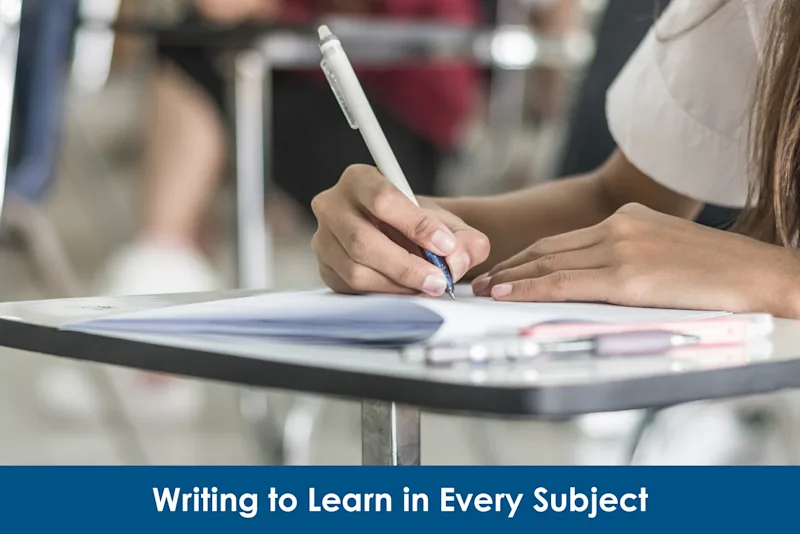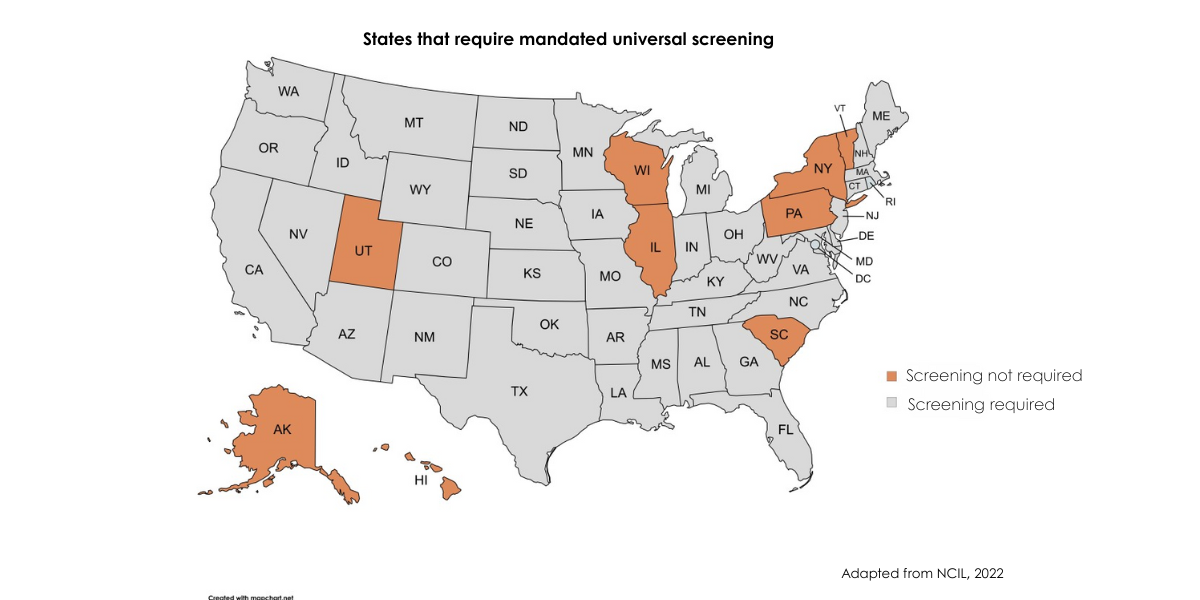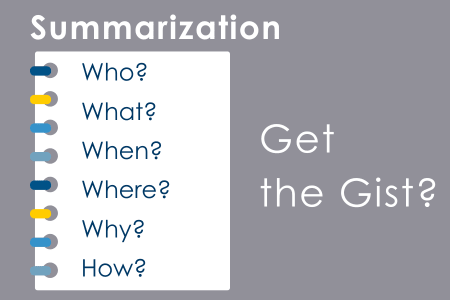Writing is not only a literacy skill; it’s also a learning strategy. Across the curriculum, it helps students process information, clarify their thinking, and make sense of complex ideas. Whether a student is explaining a scientific process, reflecting on a math strategy, or building an argument in social studies, writing turns passive learning into active engagement (Graham & Hebert, 2010).
Writing also plays a critical role in language development. As students write for different purposes and audiences, they expand their vocabulary and strengthen academic language, learning to communicate with clarity and precision (Graham & Perin, 2007). When writing is integrated into every subject, it supports deeper learning and equips students with essential tools for thinking and expression.
There’s evidence that when students write about what they’re learning or reading in subject areas such as social studies, science, or math, it increases their understanding and comprehension.
What Stays the Same: The Foundations of Writing Instruction
Across all content areas, effective writing instruction shares several core practices and strategies that, regardless of the topic, help students grow as writers.
Instruction begins with teacher modeling. Students benefit from seeing and hearing how writers think and make decisions. Whether it’s drafting a claim about a historical event or explaining the hypothesis of a lab, students need models of linguistically rich, precise academic language. For example, a science teacher might say, “This data supports our theory that the independent variable affected the result,” modeling through their language how evidence is connected to reasoning.
To support students in content-area writing, teachers can incorporate scaffolds such as word banks and sentence starters or frames. Sentence starters like “The evidence supports this claim because…” or “The experiment showed that…” help students focus on communicating their ideas rather than get mired in semantics or sentence structure.
Another core practice is intentional and structured planning, as students are better able to write when they’ve had a chance to organize their thoughts. Graphic organizers, outlines, and labeled diagrams help students move from thinking about ideas to clearly expressing those ideas. These tools vary by content but serve the same purpose: They support conceptual understanding, reduce cognitive load, and lead to more coherent writing.
Finally, across all subjects, writing should be treated as a process that involves review and refinement. The goal of revision isn’t perfection; the goal is to improve clarity, strengthen explanations, and develop one’s unique voice (Graham & Perin, 2007). Even brief written responses benefit from reflection and fine-tuning. When students see writing as a craft, not just a task, they become more intentional thinkers.
What Changes: Discipline-Specific Thinking
Though the structure of instruction stays the same, the form and purpose of writing differs by discipline(Shanahan & Shanahan, 2008). Each subject has its own vocabulary and norms for how information is communicated. In science, the goal may be to explain phenomena using evidence. In history, it may be to argue a claim using sources. In math, students might describe how they solved a problem or compare strategies. Writing tasks should reflect these distinct purposes, which means that while writing instruction can and should be consistent, it must also be responsive to the language, structures, and reasoning of the discipline (Graham et al., 2020).
Embedding Writing in Content Instruction
Infusing writing into everyday instruction doesn’t require overhauling the curriculum. Rather, it involves incorporating purposeful, structured writing opportunities into daily lessons.
Social Studies: Writing to Analyze and Argue
In social studies, writing helps students make sense of history by evaluating sources, analyzing cause and effect, and developing supported claims. Using a claim-evidence-reasoning (CER) structure, students learn to build logical, well-grounded arguments based on historical context.
- Claim: “One major consequence of Westward Expansion was…”
- Evidence: “According to the Homestead Act of 1862,…”
- Reasoning: “Since this law encouraged settlement of Indigenous lands,.. ”
These prompts help students organize their thinking and engage in deeper historical analysis supported by evidence and context.
Math: Writing to Justify and Reflect
In math, writing helps students explain how they approach problems and reflect on their strategies. When students write about their thinking, they deepen their understanding of key concepts and internalize processes. Examples of prompts include the following:
- “I solved this problem by…”
- “Another way to solve this would be…”
Teachers can model this kind of language during problem solving and invite students to do the same. Over time, these kinds of reflections help students develop mathematical flexibility and confidence.
Science: Writing to Explain and Interpret
In science, writing allows students to describe observations, analyze data, and explain relationships between variables. It also helps them practice the language of scientific reasoning and develop clarity in how they interpret results. Sentence starters can be used during lab work, investigations, or data analysis to support structured thinking and communication:
- “The experiment demonstrated that…”
- “This data supports our hypothesis because…”
- “One possible explanation for this result is…”
These prompts guide students in connecting evidence to conclusions, using writing to think like scientists.
ELA: The Reading-Writing Connection
In English Language Arts, writing helps students make sense of what they read and express their ideas with clarity and purpose. Whether working with literary texts, informational articles, poetry, or speeches, students use writing to analyze content, explore meaning, and respond to complex ideas. It gives them a way to craft interpretations, draw conclusions, and develop a personal voice across a range of genres.
Short tasks—such as reading responses, summaries, or text-based reflections—encourage students to engage actively with diverse texts. Longer assignments offer opportunities to analyze and synthesize information, organize and refine ideas, and apply precise academic language. With the support of sentence starters, graphic organizers, and modeled examples, students learn to write with insight and intention—whether they’re explaining, analyzing, narrating, or arguing.
Writing as a Path to Deeper Learning
Writing isn’t just the responsibility of ELA classroom instruction; it’s a powerful tool for learning in every subject. When writing is woven into daily instruction across the curriculum, students not only become stronger writers, but they also become more thoughtful, engaged learners. Writing deepens comprehension, sharpens reasoning, and helps students make meaningful connections among ideas and disciplines. It turns thinking into language—and language into understanding. Research shows that writing improves processing, retention, and recall (Graham & Hebert, 2011). Writing doesn’t merely support learning. It is learning.
References
Gomez, D. (Host). (2024, June 5). Effective writing instruction with Dr. Steve Graham [Audio podcast]. In READ Podcast. The Windward Institute. https://www.thewindwardschool.org/the-windward-institute/media/read/effective-writing-instruction-with-dr-steve-graham.
Graham, S., & Hebert, M.A. (2010). Writing to read: Evidence for how writing can improve reading. A Carnegie Corporation Time to Act Report. Washington, DC: Alliance for Excellent Education.
Graham, S., & Hebert, M.A. (2011). Writing to read: A meta-analysis of the impact of writing and writing instruction on reading, Harvard Educational Review, 81(4), 710-744, doi:10.17763/haer.81.4.t2k0m13756113566.
Graham, S., & Perin, D. (2007). Writing next: Effective strategies to improve writing of adolescents in middle and high schools. A Carnegie Corporation of New York. Washington, DC: Alliance for Excellent Education.
Graham, S., Kiuhara, S.A., & MacKay, M. (2020). The effects of writing on learning in science, social studies, and mathematics: A meta-analysis, Review of Educational Research, 90(2), 179-226, doi: 10.3102/0034654320914744.
Shanahan, T., & Shanahan, C. (2008). Teaching disciplinary literacy to adolescents: Rethinking content area literacy, Harvard Educational Review, 78(1), 40- 59, doi: 10.17763/her.78.1.v62444321p602103.











